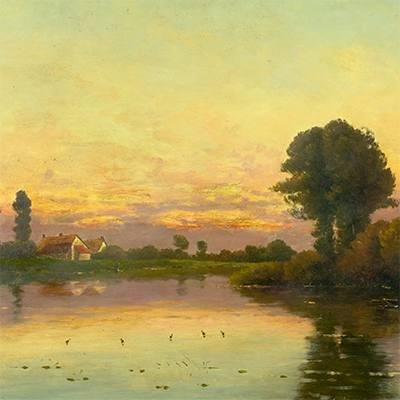Barbizon
THE BARBIZON SCHOOL
The group of French painters who joined together in the village of Barbizon, in the forest of Fontainebleau, during the mid-nineteenth century sparked quite a rebellion by taking painting out of doors. They broke with the classical tradition by establishing landscape painting as an independent movement, opening the way toward Impressionism.
Biography
As participants in the Barbizon School, they disdained the growth of industrialization and urban expansion. United in their constant opposition to the city and modern life, stylistically, they were the first to narrow the gap that had traditionally existed between the direct sketch and the finished studio picture. In the larger scope of art history, the Men of 1830, Charles Jacque, Jules Dupre, Camille Corot, Theodore Rousseau, Diaz de la Pena, Charles Francois Daubigny, and others created a visual bridge between Romanticism and the development of early Modern painting. Also referred to as the Pre-Impressionists, these visionary artists had a dramatic impact upon the evolution of European art.
Paintbrush in hand, their singular mission was the honest depiction of the rural landscape and its inhabitants. They truly worshiped the land around them and held it sacred in a very literal sense.
Theodore Rousseau, a founding father of the plein-air movement, stated the intense spirituality with which they were to approach their work:
Our art is truly capable of achieving the expressive force we are seeking. Through the sincerity of your portrayal and exact truth to life observe nature with all the religion of your heart. In doing so you will end up dreaming of the life of the infinite. Do not copy what you see with the mathematical precision, instead feel and convey the real world, which enfolds you in all its inevitability.
Along with this new appreciation of the natural world came a reappraisal of the simple people who made it their home. Until the nineteenth century, the peasant in the realm of fine art was largely ignored. They were considered too crude and lowly to warrant representation. The industrial revolution changed all that. Through the efforts of artists such as Courbet, Millet, and Breton, the life of the peasant was celebrated and given dignity and nobility. In a new world, where railroads and factories were erasing centuries of tradition with unnerving speed, the peasant became a cherished reminder of a simple past.
These groups of exceptional artists were celebrated on both sides of the Atlantic in their day. After many years of neglect, they have at long last been rediscovered and celebrated in our time. Interest in the French rural tradition has never been greater. Museums have identified pre-Impressionist painting as one of the few remaining important movements of the nineteenth century for serious study and expansion of their collections.
